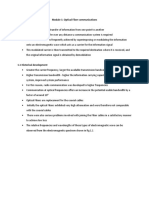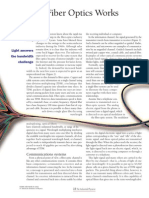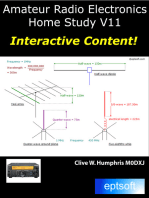A Historical Perspective: Overview of Optical Fiber Communications
A Historical Perspective: Overview of Optical Fiber Communications
Uploaded by
Rakesh RtCopyright:
Available Formats
A Historical Perspective: Overview of Optical Fiber Communications
A Historical Perspective: Overview of Optical Fiber Communications
Uploaded by
Rakesh RtOriginal Title
Copyright
Available Formats
Share this document
Did you find this document useful?
Is this content inappropriate?
Copyright:
Available Formats
A Historical Perspective: Overview of Optical Fiber Communications
A Historical Perspective: Overview of Optical Fiber Communications
Uploaded by
Rakesh RtCopyright:
Available Formats
Introduction
Chapter 1 Overview of Optical Fiber Communications
Fundamentals of communications Terahertz communications : the potential Limitations of electronic communications communications Optical Communication Systems Novel Techniques
Fundamentals of Communications
Information
A Historical Perspective
1837 - Morse demonstrates telegraph 1878 - Bell invents telephone 1878 - Maxwells equations describe propagation Maxwell of Electromagnetic Waves 1888 - Hertzs demonstration of long radio waves Hertz 1895 - Marconis demonstration of wireless radio Marconi communications
Transmitter
Channel
Receiver
Information
The information is usually transferred over the communication channel by superimposing the information onto a sinusoidally varying electromagnetic wave known as the carrier.
The amount of information that can be transmitted is directly related to the frequency of the carrier. Early radio (15 KHz voice signals in the 0.5 -2 MHz range) Television (6 MHz bandwidth, Carrier frequencies in the 100 MHz range) Microwaves (GHz domain) Optical Communications (THz ?) The trend has been to employ progressively higher frequencies for the carrier.
The optical spectrum ranges from about 50 nm to 100 m. Ultraviolet 50 nm Visible light 400 to 700 nm Near Infrared about 800 to 5,000 nm Mid Infrared about 5,000 to 30,000 nm Far Infrared 30,000 nm and longer Optical fiber communications usually operate in the 800 to 1,600 nm wavelength band.
Key technical problems
Highest speeds for electronic devices (picosecond range = 10-12 secs) secs) There are no devices currently that can react at the frequency of light for communication purposes. Detection is at much slower rates (relative to the light carrier) by intensity modulation. We need a reliable and consistent transmission medium. Optical mediums include free space optical waveguides
THz Communications... First laser (Ruby) operated at a wavelength of 694 nm This wavelength corresponds to a carrier frequency of 5 x 1014 Hz
Note : 1 % of vruby = 5 x 1012 Hz ( 5 THz!) Can carry 106 commercial video channels Can carry 109 telephone calls at 5 kHz per call
So why isnt this bandwidth being fully utilized ? isn Appropriate light sources that can be modulated anywhere near that fast. And detectors that can react to the frequency rather than the intensity of the light.
The Role of the Optical Fiber
The advantages of guided wave propagation
One reason for an optical fiber is the limitations of free space optical communication. In free space communication, no one owns the channel. The user is subject to the whims of weather, passing beam obstructions (birds, dust, new buildings) and so on. A free space channel might be a hazardous to people and objects in high optical power conditions. A free space channel is inherently line of sight. No over the horizon communication!
The channel is well-defined with reliable and repeatable performance. Long distance communication is now possible within the limits of channel attenuation and distortion. No horizon problem. Early fibers had large attenuation (1000 dB/km !) Elimination of impurities has dramatically lowered attenuation to a low of 0.2 dB/km at a wavelength of 1500 nm.
Advantages of Optical Fiber Communications Capacity for 25 THz information bandwidth Low loss. Signal can travel for very long distances without repeaters or regenerators. Light weight. A fiber bundle is much lighter than an equal sized metal conductor cable. The signal capacity within the same size optical fiber bundle is much greater than for metal conductors. Immunity from EMI and crosstalk. The optical signal is not usually affected by nearby electromagnetic fields even large ones.
Advantages of Optical Fiber Communications
Compatible family of devices exist. There are now lasers, detectors and optoelectronic integrated circuits (OEICs) from many vendors that are compatible at (OEIC specific wavelengths.
Types of Optical Fiber Communication Systems
What is required ?
Long Distance Telecommunication
Point to point links (between cities) Telephone communications Purchasing and installing fiber
Data Communications
Local Area Networks Computers, Databases, Workstations Hardware costs (TXR, Connectors, Switches, Filters, RCVRS)
Switches Amplifiers Filters Connectors Better modulation schemes (FM or PM)
Novel Techniques
Section 1.1 Basic Network Information Rates Various services require different data rates for useful communication.
Wavelength Division Multiplexers Optical Amplifiers Optical Filters & Switches Coherent Modulation Schemes
Historically these various services were time division multiplexed onto higher capacity transmission channels.
Example of telecommunication multiplexing scheme
Section 1.1 Basic Network Information Rates There are many competing and complimentary formats and schemes in use including SONET synchronous optical network SDH synchronous digital hierarchy ATM asynchronous transfer mode The trend is to communicate at very high data rates to accommodate various purposes rather than characterizing the channel by the source (such as voice, fax, video)
Fig. 1-2: Digital transmission hierarchy
Section 1.2 The Evolution of Fiber Optic Systems The bit-rate-distance product (BL) measures the transmission capacity of optical fiber links. Since 1974, the transmission capacity has increased by 10-fold every four years! The transmission capacity increase has resulted from innovation in the four key components of an optical link. The optical fiber Light sources Photodetectors Optical amplifiers
Section 1.2 The Evolution of Fiber Optic Systems Optical fiber improvements resulted in wider repeater spacing due to improvements in Attenuation at specific wavelengths Dispersion (distortion of the light pulse) Light sources have improved in reliability, modulation rate, power consumption and wavelength availability. Photodetectors also saw improvement in noise performance and low light detection capability. Optical amplifiers have reduced the need to detect/regenerate/retransmit light signals. This has fairly dramatically increased repeater separation distances.
Section 1.3 Elements of an Optical Fiber Transmission Link An optical fiber transmission link comprises: Light transmitter and associated drive circuitry. Optical fiber in a cable for mechanical and environmental protection. Receiver consisting of a photodetector plus amplification and signal-restoring circuitry. Frequently the fiber cable may contain copper wires for powering optical amplifiers or signal regenerators.
Fig. 1-3: Operating ranges of components
Fig. 1-5: Major elements of an optical fiber link
Fig. 1-6: Optical fiber cable installations
Section 1.3 Elements of an Optical Fiber Transmission Link One of the principal characteristics of an optical fiber is its attenuation as a function of wavelength. Historically, 800 to 900 nm was the first band for fiber transmission. This is called the first window. Continued fiber development resulted in very low loss in the 1,100 to 1,600 nm region. Centered at 1,310 nm is the second window. Centered at 1,550 nm is the third window. Fig. 1-7: History of attenuation
Section 1.3 Elements of an Optical Fiber Transmission Link Once the fiber cable is installed, a light source that is dimensionally compatible with the fiber core is used to launch optical power into the fiber. Semiconductor light-emitting diodes (LEDs) and laser diodes are suitable for this purpose. Their light output can be modulated rapidly by simply varying the bias current at the desired transmission rate. At high data rates (> 1 GHz), direct modulation of the source can lead to unacceptable signal distortion. Thus an external modulator is frequently used.
Section 1.4 Simulation and Modeling Tools Hand analysis results in ball-park answers. Increasingly, photonic design automation (simulation) is used to refine designs to be more efficient, cost-effective and robust. The author has included the student edition of one such simulation program the Photonic Transmission Design Suite (PTDS) by Virtual Photonics, Inc. The department also has a copy of LINKSIM by RSoft, as well as NIs labVIEW. We will use various combinations of the software during the semester.
End of Chapter 1 Overview of Optical Fiber Communications
You might also like
- Chapter 1 Principles of Fiber Optics and CharacteristicsDocument49 pagesChapter 1 Principles of Fiber Optics and CharacteristicsKairredin Mahamed Husen50% (2)
- Assignment On Fiber Obtic CommunicationDocument8 pagesAssignment On Fiber Obtic Communicationmd.jewel rana100% (2)
- Continuous Phase Modulation by NitDocument50 pagesContinuous Phase Modulation by NitRakesh RtNo ratings yet
- Optical Fiber Communications: Lecture 1: IntroductionDocument23 pagesOptical Fiber Communications: Lecture 1: Introductionjeddo2005No ratings yet
- CH 1 Optical Fiber Introduction - 2Document18 pagesCH 1 Optical Fiber Introduction - 2Krishna Prasad PheluNo ratings yet
- Optical Fiber Communication Notes PDFDocument251 pagesOptical Fiber Communication Notes PDFRahul RajendrakumarNo ratings yet
- FOC MATERIAL FinalDocument16 pagesFOC MATERIAL FinalDeepesh KushwahaNo ratings yet
- Seminar ReportDocument12 pagesSeminar ReportNupurNo ratings yet
- Electronics Communication - Engineering - Optical Fiber Communication - Overview of Optical Fiber Communication - Notes PDFDocument36 pagesElectronics Communication - Engineering - Optical Fiber Communication - Overview of Optical Fiber Communication - Notes PDFSukhada Deshpande.No ratings yet
- Physical Layer: Transmission Media - Guided Transmission MediaDocument185 pagesPhysical Layer: Transmission Media - Guided Transmission MediaDeepika SheshabutterNo ratings yet
- Oc All Units Notes and Question BankDocument193 pagesOc All Units Notes and Question BankArpit RajputNo ratings yet
- CH 1 Optical Fiber Introduction - PointsDocument17 pagesCH 1 Optical Fiber Introduction - PointsKrishna Prasad PheluNo ratings yet
- Lec.1 - COMM 554 Optical Communication SystemsDocument45 pagesLec.1 - COMM 554 Optical Communication SystemsMahmoud Sayed100% (1)
- FOC Unit-1Document24 pagesFOC Unit-1NAGASWATHI NIDAMANURINo ratings yet
- Fibre Optic CommunicationDocument10 pagesFibre Optic CommunicationsriramanbalajiNo ratings yet
- Optical Electronics and Laser Instrumentation Unit 1Document14 pagesOptical Electronics and Laser Instrumentation Unit 1srikanthNo ratings yet
- Ofc Notes PDFDocument116 pagesOfc Notes PDFSudha Rani50% (2)
- Ch-1 Adv Optical Fiber CommDocument15 pagesCh-1 Adv Optical Fiber CommZain HamzaNo ratings yet
- Optical Fiber CommunicationDocument18 pagesOptical Fiber CommunicationPuja MallickNo ratings yet
- Optics and Optical Communication Lecture Best 2121Document221 pagesOptics and Optical Communication Lecture Best 2121amanuel abrehaNo ratings yet
- Optical Fiber Communication System:-ReferencesDocument0 pagesOptical Fiber Communication System:-Referenceswww.bhawesh.com.npNo ratings yet
- A. Lecture - Introduction Optical Fiber Communication.Document57 pagesA. Lecture - Introduction Optical Fiber Communication.gauravnitin123No ratings yet
- Unit IintroductionDocument40 pagesUnit IintroductionkikiNo ratings yet
- Conceptos Basicos - Parte 1Document37 pagesConceptos Basicos - Parte 1Carlos RojasNo ratings yet
- Optical Fibre CommunicationDocument60 pagesOptical Fibre CommunicationashjunghareNo ratings yet
- Day 2Document27 pagesDay 2Abhiram SwarnaNo ratings yet
- Chapter 1 Optical Fibers: IntroductionDocument18 pagesChapter 1 Optical Fibers: IntroductionKrishna Prasad PheluNo ratings yet
- Transmission MediaDocument48 pagesTransmission MediarfgvgfNo ratings yet
- Fiber Optic Communication SystemsDocument50 pagesFiber Optic Communication SystemsTelugu SatyanarayanaNo ratings yet
- Sec 1407Document130 pagesSec 1407Mubashir HamidNo ratings yet
- Module 1: Optical Fiber CommunicationsDocument44 pagesModule 1: Optical Fiber Communicationsdigital loveNo ratings yet
- Ece Vii Optical Fiber Communication NotesDocument210 pagesEce Vii Optical Fiber Communication Notesmanishrpv88% (8)
- EC432 - Ch1 - Introduction To Fiber Optic SystemDocument5 pagesEC432 - Ch1 - Introduction To Fiber Optic SystemTakashi SuohNo ratings yet
- Session - Ofc CablesDocument51 pagesSession - Ofc CablesA. Hassan100% (1)
- 13 06 24 Light It Up Optical Fiber Media Transmissions ApplicationsDocument12 pages13 06 24 Light It Up Optical Fiber Media Transmissions Applicationsvts2006No ratings yet
- Chapter IIIDocument13 pagesChapter IIIyohans bisetNo ratings yet
- How Fiber Optics WorksDocument4 pagesHow Fiber Optics Worksxyz156No ratings yet
- 4 Transmission MediaDocument24 pages4 Transmission MediaRashad MahmoodNo ratings yet
- Transmission Media: Group NameDocument79 pagesTransmission Media: Group NameGanesh KumarNo ratings yet
- Optical Communications Optical CommunicationsDocument30 pagesOptical Communications Optical CommunicationsNung NingNo ratings yet
- sdsediaDocument7 pagessdsediakrishnaguptamdzNo ratings yet
- Data and Computer Communications: Chapter 4 - Transmission MediaDocument35 pagesData and Computer Communications: Chapter 4 - Transmission MediaRuchiNo ratings yet
- 1 Intro Optcomm SysDocument25 pages1 Intro Optcomm Sysrazifhamzah100% (1)
- Optical Fibre CommunicationDocument60 pagesOptical Fibre CommunicationN.ChanduNo ratings yet
- Introduction To Optics and Optical CommunicationsDocument4 pagesIntroduction To Optics and Optical Communicationstolossa assefaNo ratings yet
- Transmission MediaDocument72 pagesTransmission MediaSaluNo ratings yet
- Fiber Optics Study MaterialsDocument23 pagesFiber Optics Study MaterialsInstitute of Engineering Studies (IES)100% (4)
- 1 Transmission: 1.1 Optical Fiber CommunicationDocument18 pages1 Transmission: 1.1 Optical Fiber CommunicationMuraliKrishnaNo ratings yet
- Module 1 Odi Aruna_printed_pdfDocument146 pagesModule 1 Odi Aruna_printed_pdfSrutee MohapatraNo ratings yet
- Telecommunications and NetworksDocument35 pagesTelecommunications and NetworksFarel KawilarangNo ratings yet
- 04 TransmissionmediaDocument38 pages04 Transmissionmedia22520101No ratings yet
- Ofc SystemDocument25 pagesOfc SystemNowhi NowhiNo ratings yet
- Optical Fiber CommunicationDocument18 pagesOptical Fiber CommunicationSaurav sharmaNo ratings yet
- Lecture 1Document32 pagesLecture 1Junaid MandviwalaNo ratings yet
- Telecommunications and NetworksDocument35 pagesTelecommunications and NetworksManish ChoudharyNo ratings yet
- 1.1 Historical DevelopmentDocument11 pages1.1 Historical Developmentbpr platinmods4No ratings yet
- Amateur Radio Electronics on Your MobileFrom EverandAmateur Radio Electronics on Your MobileRating: 5 out of 5 stars5/5 (1)
- MIMO Technology For Advanced Wireless Local Area NetworksDocument3 pagesMIMO Technology For Advanced Wireless Local Area NetworksRakesh RtNo ratings yet
- A Statistical Model For Indoor Multipath PropagationDocument10 pagesA Statistical Model For Indoor Multipath PropagationRakesh RtNo ratings yet
- Frequency Hopping Spread Spectrum (FHSS) vs. Direct Sequence Spread Spectrum (DSSS) by SorinM - SCHWARTZDocument16 pagesFrequency Hopping Spread Spectrum (FHSS) vs. Direct Sequence Spread Spectrum (DSSS) by SorinM - SCHWARTZRakesh RtNo ratings yet
- Security in Near Field Communication (NFC)Document11 pagesSecurity in Near Field Communication (NFC)Rakesh RtNo ratings yet
- Tutorial-1 Low Noise Amplifier (LNA) Design: by Rashad.M.Ramzan Rashad@isy - Liu.se ObjectiveDocument18 pagesTutorial-1 Low Noise Amplifier (LNA) Design: by Rashad.M.Ramzan Rashad@isy - Liu.se ObjectiveRakesh Rt100% (1)
- Application Note AN014: Frequency Hopping SystemsDocument7 pagesApplication Note AN014: Frequency Hopping SystemsRakesh RtNo ratings yet
- Max Lloyd QuantizationDocument5 pagesMax Lloyd QuantizationRakesh RtNo ratings yet
- Lec 26Document6 pagesLec 26raw.junkNo ratings yet
- Thermodynamic ReviewDocument16 pagesThermodynamic ReviewMuhammad Zubair AfzalNo ratings yet
- PT08-Comparatorts and Reference Panels PDFDocument29 pagesPT08-Comparatorts and Reference Panels PDFravindra_jivaniNo ratings yet
- YRM1004D Quantitative Aflatoxin M1 Rapid Test in milkDocument1 pageYRM1004D Quantitative Aflatoxin M1 Rapid Test in milkWilson CastroNo ratings yet
- Soil Chemistry Soil Fertility Nutrient ManagementDocument171 pagesSoil Chemistry Soil Fertility Nutrient Managementtim_scribd100% (2)
- Process Hygienic Master ManualDocument176 pagesProcess Hygienic Master ManualalicardozoNo ratings yet
- Test Procedure - Green Sand SystemDocument3 pagesTest Procedure - Green Sand SystemSiddharth Gupta100% (1)
- 2 X1.3TAA G7 - 20kVA - Rev 2Document4 pages2 X1.3TAA G7 - 20kVA - Rev 2P.p. Arul IlancheeranNo ratings yet
- Period #8 Notes: Aggregates: A. A Quick Look at Aggregates 1. OverviewDocument13 pagesPeriod #8 Notes: Aggregates: A. A Quick Look at Aggregates 1. OverviewDebendra Dev KhanalNo ratings yet
- Riphah International University Islamabad: Faculty of Engineering & Applied SciencesDocument2 pagesRiphah International University Islamabad: Faculty of Engineering & Applied SciencesStu DentNo ratings yet
- Tcs Apti 5Document8 pagesTcs Apti 5kumaranrajNo ratings yet
- Hydraulic Mining Excavator: General Data: FeaturesDocument4 pagesHydraulic Mining Excavator: General Data: FeaturesLaura VignaNo ratings yet
- Mathematics Paper 2 TZ1 SLDocument16 pagesMathematics Paper 2 TZ1 SLNeelamNo ratings yet
- AbstractDocument3 pagesAbstractParag KhareNo ratings yet
- 4marks 7marks CirclesDocument1 page4marks 7marks Circlescharmi chowdaryNo ratings yet
- Suppressor Catalog10Document37 pagesSuppressor Catalog10Christina EichelNo ratings yet
- Response To Impulsive LoadingDocument44 pagesResponse To Impulsive LoadingSuastama YudaNo ratings yet
- Integration: Instructor: Ines KhemirDocument57 pagesIntegration: Instructor: Ines KhemirAhmed DammakNo ratings yet
- Advancements in Digital Imaging: What Is New and On The Horizon?Document5 pagesAdvancements in Digital Imaging: What Is New and On The Horizon?224edgebNo ratings yet
- Unified Soil Classification System: Symbol ChartDocument2 pagesUnified Soil Classification System: Symbol Chartdiscocyclina100% (1)
- Nptel: Ordinary Differential Equations and Applications - Video CourseDocument3 pagesNptel: Ordinary Differential Equations and Applications - Video CoursemustafaphyNo ratings yet
- Engine Mount Analysis Report: 1.0 ScopeDocument24 pagesEngine Mount Analysis Report: 1.0 ScopeUpender Rawat100% (1)
- Physics Challenge Dec14Document2 pagesPhysics Challenge Dec14John DixonNo ratings yet
- FMR19N60E: Super FAP-E SeriesDocument5 pagesFMR19N60E: Super FAP-E SeriesKrzysztof BondkaNo ratings yet
- 1 3BHS260164 - ACS 2000 Power Cable Specification - Rev.DDocument8 pages1 3BHS260164 - ACS 2000 Power Cable Specification - Rev.DNguyen HungNo ratings yet
- Automated Rotary Vehicle Parking SystemDocument45 pagesAutomated Rotary Vehicle Parking Systemrzsdrgz50% (4)
- Composite QuestionsDocument34 pagesComposite QuestionsVinod SabdeNo ratings yet
- Ec1001 - Medical Electronics - Question Bank (2marks With Answer)Document26 pagesEc1001 - Medical Electronics - Question Bank (2marks With Answer)deepanece100% (1)
- DNV ExternalDocument18 pagesDNV ExternalTord MartinsenNo ratings yet
































































































